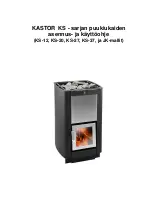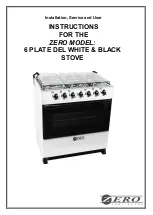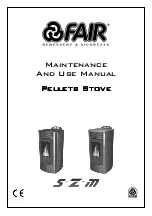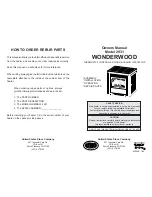
9
P68 Pellet Stove
venting
A combustion blower is used to extract the combustion
gases from the firebox. This causes a negative pressure
in the firebox and a positive pressure in the venting
system as shown in Fig. 7. The longer the vent pipe and
more elbows used in the system, the greater the flow
resistance. Because of these facts we recommend using
as few elbows as possible and 15 feet or less of vent
pipe. The maximum horizontal run should not exceed
48". If more than 15 feet of pipe is needed, the interior
diameter should be increased from 3" to 4" because
a larger pipe causes less flow resistance.
be sure to
use approved pellet vent pipe wall and ceiling pass-
through fittings to go through combustible walls
and ceilings. all joints for connector pipe must be
fastened with a minimum of three screws. Follow
pellet vent manufacturer instructions for properly
securing each pellet vent joint. the pellet starting
collar must be secured to the unit's flue collar.
venting
iMPortant notice
Approved 3" or 4" Pellet Vent Pipe Such As,
Type "PL", Must Be Used.
+
+
-
Fig. 7
vent Pipe
Pellet venting pipe (known as PL vent) is constructed
of two layers with air space between the layers.
This air space acts as an insulator and reduces the
outside surface temperature to allow a clearance to
combustibles of 1 to 3 inches. The sections of pipe
lock together to form an air tight seal in most cases.
However, in some cases a perfect seal is not achieved.
For this reason and the fact that the P68 operates with a
positive vent pressure
we specify that the joints also
be sealed with high temp (rtv) silicone.
Aluminum
tape can also be used for any joint that is 1ft. or more
from the outlet of the stove.
avoiding Smoke and odors
negative Pressure, Shut-down, and Power
Failure:
T
o reduce the probability of back-drafting or
burn-back in the pellet burning appliance during
power failure or shut-down conditions, the stove
must be able to draft naturally
without exhaust blower
operation. Negative pressure in the house will resist this
natural draft if not accounted for in the pellet appliance
installation.
Heat rises in the house and leaks out at upper levels.
This air must be replaced with cold air from outdoors,
which flows into lower levels of the house. Vents and
chimneys into basements and lower levels of the house
can become the conduit for air supply, and reverse
under these conditions.
outside air:
hearth & home technologies strongly recommends
attaching outside air in all installations, especially
lower level and main floor locations.
do not inStall a Flue daMPer in the
eXhauSt venting SySteM oF thiS unit.
do not connect thiS unit to a chiMney
Flue Serving another aPPliance.
a chiMney connector May not PaSS
through an attic or rooF SPace,
cloSet or SiMilar concealed SPace,
Floor , or ceiling. reFerence local
building codeS For detailS.
inStall vent at clearanceS SPeciFied
by the vent ManuFacturer
do not uSe MaKeShiFt coMProMiSeS
When inStalling thiS aPPliance.
daMage and/or injury May reSult.
caution
= Positive Static Pressure
= Negative Static Pressure
+
-










































